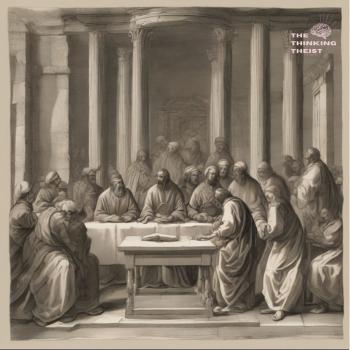Thin Places
Today I want to wrap up this series on thin places by offering some theological reflections and hesitations. If you’re joining this series late in the game, let me say that the language of “thin place” is a Celtic metaphor that describes physical locations in which God is especially present. A retreat center or a quiet sanctuary would be obvious examples of potential thin places. This description has become increasingly popular in the last couple of decades because of the influence of Celtic spirituality in America.
In this series, I have sought to examine the notion of thin places from a biblical perspective, beginning with the original thin place, the Garden of Eden, and then moving through the Old Testament (Mt. Sinai, pillars of cloud and fire, the tabernacle, the Temple in Jerusalem). From a New Testament vantage point, Jesus serves as the ultimate thin place, the “place” in which God’s presence is revealed most directly. Those who follow Jesus carry on his thin-place mission. Thus the church should be a thin place, not only for its members, but also for the people to whom it has been sent.
Of course most of the biblical thin places aren’t exactly places in the literal sense. The pillars of cloud and fire, the tabernacle, Jesus, and the church occupy places but are not limited to any particular place. They are movable place-fillers rather than places, per se. The notion of thin places, though not necessarily contradicted by Scripture, cannot be easily derived from it. In fact, as I mentioned earlier in this series, part of what made Christianity so confusing in the first-century Roman world was its lack of sacred places. Unlike very other religion, it didn’t have temples.
This was not just an accident. The early Christians believed that Jesus was God in human flesh. Through his death, he offered the once and for all sacrifice for sin, so that there was no longer a need for a temple and its sacrifices. Moreover, the early Christians believed that the Spirit of God had been given to them. The bodies of individual Christians were the temples of the Holy Spirit, as was the gathered church (so 1 Corinthians 6 and 3). So when a bunch of Christians got together in a house, as they often did in the first century, this was a sacred place, or a thin place, if you prefer.
In light of the New Testament, it’s hard to find much support for the notion of thin places in the strict sense. If we use the phrase “thin place” as a metaphor, and don’t invest it with too much reality, then I don’t have a problem with this language. But if we start reifying thin places, if we believe that God has actually chosen certain geographical locations as special portals into heaven, then we risk misunderstanding God and his way of making himself known. After all, the Word became flesh, not a place. And the Spirit of God dwells in human beings, not in sacred buildings or mystical places.
Moreover, most so-called thin places tend to be secluded, either by physical distance or by thick walls or both. Thin places are generally quiet and isolated, unlike most of the places we live. It is certainly true that in places like this we can be more attentive to God. Remember that Jesus himself withdrew from the crowds in order to spend time with his Father in deserted places. But we make an unfortunate error is we start thinking that God is more present in such isolated places than in all other places.
To be sure, God makes his presence known in a particular way when we are quiet and alone. But God also makes his presence known through the loud praises of his people. And God makes his presence known when his people build houses for the homeless in his name. And God makes his presence known when a Sunday School teacher loves a bunch of rowdy three-year old boys. And God makes his presence known when somebody extends a word of sympathy to a colleague who is going through hard times. And God makes his presence known when a boss chooses to offer grace to somebody who messed up on the job. And so on and so on.
Perhaps the greatest problem in the thin place metaphor, apart from its lack of biblical support, is the worldview it assumes and the implications that flow from this worldview. A thin place is, by definition, an exception to the rule. And the rule states that this world and the heavenly world are separated by a thick barrier. God is on the other side of the barrier, mostly separate from the world, except for unusually thin places in which he makes himself known. This worldview is not uncommon, but it is not biblical. Scripture teaches us to see God as much more involved in this world than the thin place metaphor assumes. Thus, I am hesitant to use the this metaphor, because I fear it reinforces incorrect and unhelpful ways of seeing God and the world.
Now, as you might guess, I think we need places of quiet retreat, places where we can pray without interruption, places where we are more apt to hear God. From my years as Senior Director of Laity Lodge, I learned that such a place can help us to experience God more intimately and truly. But one of the main reasons we go on retreat is so that we might learn to be more attentive to God’s presence in our ordinary lives. We take time away from work, for example, so we can learn to experience God more consistently in our workplace.
 I also acknowledge, quite gladly, that God does make himself known in certain places with extraordinary intimacy and regularity. People do in fact encounter God at Laity Lodge more often than they do at Garven Store, an establishment near Laity Lodge where you can buy jerky, biker gear, and beer. I even think I know some of the reasons people meet God at Laity Lodge. It’s exceptionally quiet and stunningly beautiful. God’s truth is taught there week in, week out. Those who founded Laity Lodge and those who work there are committed to treating each guest with striking hospitality. (Notice, it isn’t just the place, but the people in the place who make a difference.) Moreover, Laity Lodge has been dedicated to God ever since its founding. He uses this space, in part, because those to whom he entrusted it gave it back to him for his purposes. But one of the things I love about Laity Lodge is the fact that our founder, Howard E. Butt, Jr., believes that our experience of God at the Lodge is meant to help us experience and serve him more effectively in the world.
I also acknowledge, quite gladly, that God does make himself known in certain places with extraordinary intimacy and regularity. People do in fact encounter God at Laity Lodge more often than they do at Garven Store, an establishment near Laity Lodge where you can buy jerky, biker gear, and beer. I even think I know some of the reasons people meet God at Laity Lodge. It’s exceptionally quiet and stunningly beautiful. God’s truth is taught there week in, week out. Those who founded Laity Lodge and those who work there are committed to treating each guest with striking hospitality. (Notice, it isn’t just the place, but the people in the place who make a difference.) Moreover, Laity Lodge has been dedicated to God ever since its founding. He uses this space, in part, because those to whom he entrusted it gave it back to him for his purposes. But one of the things I love about Laity Lodge is the fact that our founder, Howard E. Butt, Jr., believes that our experience of God at the Lodge is meant to help us experience and serve him more effectively in the world.
If you want to use the thin place metaphor, then perhaps you should say that the purpose of thin places is to help us realize that all places can be thin. Or, better yet, perhaps the purpose of a thin place is to train us to make the other places in our lives thinner. Moreover, when we realize that the Spirit of God dwells within us, we will come to believe that we are called to be thin places, as God makes his presence known through us.















